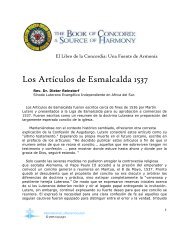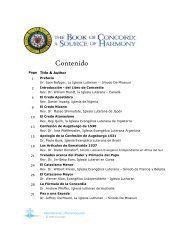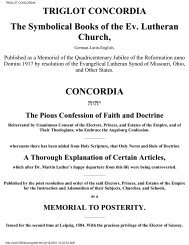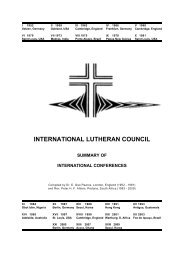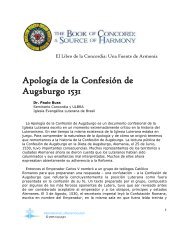The Smalcald Articles 1537 - International Lutheran Council
The Smalcald Articles 1537 - International Lutheran Council
The Smalcald Articles 1537 - International Lutheran Council
You also want an ePaper? Increase the reach of your titles
YUMPU automatically turns print PDFs into web optimized ePapers that Google loves.
<strong>The</strong> <strong>Smalcald</strong> <strong>Articles</strong> <strong>1537</strong><br />
By Rev. Dr. Dieter Reinstorf<br />
Serves in the Free Evangelical–<strong>Lutheran</strong> Synod in South Africa<br />
<strong>The</strong> <strong>Smalcald</strong> <strong>Articles</strong> were written near the end of 1536 by Martin Luther and<br />
submitted to the <strong>Smalcald</strong> League for adoption early in <strong>1537</strong>. <strong>The</strong>y were written as<br />
a summary of <strong>Lutheran</strong> doctrine in preparation for the long-awaited general council<br />
of the church.<br />
In keeping with the changed historical context, they offered a further correct<br />
explanation of the Augsburg Confession. Luther regarded these articles as his “last<br />
testament.” Expecting his own death in the near future, he writes in the preface to<br />
the articles: “I have decided to publish these articles so that, if I should die before a<br />
council meets...those who live after me may have my testimony and confession...to<br />
show where I have stood until now and where by God’s grace, I will continue to<br />
stand.”<br />
Only when sterner measures failed to dispose of the religious controversy sweeping<br />
Germany, Pope Paul III conceded to the emperor’s pressure and called a general<br />
council to meet at Mantua, May 8, <strong>1537</strong>. It soon became clear that the purpose of<br />
the council was not to discuss and arbitrate questions of doctrine and practice, but<br />
to utterly extirpate the “poisonous, pestilential <strong>Lutheran</strong> heresy.” So there were<br />
initial reservations expressed about whether the <strong>Lutheran</strong>s should receive and hear<br />
the papal legate delivering the invitation. Luther, however, continued voicing his<br />
strong desire for such a council to convene. He expressed the need for a clear<br />
confession of faith so those still held captive could be equipped to distinguish<br />
between error and truth. Imbued by Luther’s spirit, the elector of Saxony, John<br />
Frederick, instructed Luther in a letter of December 11, 1536, to prepare a<br />
<strong>International</strong> <strong>Lutheran</strong> <strong>Council</strong><br />
© 2005 Copyright<br />
1
statement indicating the articles of faith in which concessions might be made for<br />
the sake of peace, and the articles in which no concessions could be made.<br />
By December 28, 1536, Luther submitted a draft copy to his colleagues in<br />
Wittenberg for further review. <strong>The</strong> first eight signatures were affixed at that time,<br />
Philip Melanchthon’s with the reservation that the Pope may continue to hold<br />
supreme authority over the church given to him by human right if he would accept<br />
the Gospel. Seeking wide-ranging consensus, the elector presented the articles to<br />
the <strong>Smalcald</strong> League on February 8, <strong>1537</strong>. <strong>The</strong> league had been formed in 1531 for<br />
mutual protection by five princes and eleven cities. It was renewed in 1536 for the<br />
following ten years. <strong>The</strong> hope that the league would endorse Luther’s articles was,<br />
however, never realized. This was partly because Luther’s continued illness<br />
prevented him from attending and partly because Melanchthon argued that the<br />
articles would precipitate doctrinal dispute among the league members.<br />
Despite not being officially read at the league, the articles were nevertheless<br />
subscribed voluntarily at <strong>Smalcald</strong> (with the exception of the South Germans), and<br />
subsequently became known as the <strong>Smalcald</strong> <strong>Articles</strong>. In later years the articles<br />
were looked upon with growing favor as a witness to genuine <strong>Lutheran</strong>ism, giving<br />
expression to the heart of Martin Luther, and as such were incorporated in the Book<br />
of Concord.<br />
<strong>The</strong> <strong>Smalcald</strong> <strong>Articles</strong> are grouped in three parts: Part I treats the sublime articles<br />
of the divine majesty, the Father, the Son, and the Holy Spirit. This part is short as<br />
it refers to teachings where there are no matters of dispute or contention.<br />
Part II discusses the articles referring to the office and work of Jesus Christ, or our<br />
redemption. This part contains the chief and principal teachings of <strong>Lutheran</strong>ism on<br />
which no concessions can be made. <strong>The</strong> first of four articles, Christ and Faith,<br />
proclaims salvation by grace through faith alone, as a free gift from God. It is hailed<br />
as the central article on which everything “we teach and practice” rests. <strong>The</strong> other<br />
three articles address Mass, Chapters and Monasteries, and <strong>The</strong> Papacy,<br />
condemning unequivocally all man-made traditions as necessary works to merit<br />
God’s grace.<br />
Part III deals with fifteen articles on which the <strong>Lutheran</strong>s might make concessions.<br />
Strikingly, these do not address trivial matters, but issues such as sin, the law,<br />
repentance, the Gospel, Baptism, the Sacrament of the Altar, the Keys, confession<br />
and others. Concessions are, however, only possible when discussed with “learned<br />
and sensible men, or even among ourselves,” based on the careful exposition of<br />
Scripture.<br />
For <strong>Lutheran</strong>s the <strong>Smalcald</strong> <strong>Articles</strong> are as relevant today as in the 16th century.<br />
Furthermore, they are a classic example of what it means to confess <strong>Lutheran</strong> selfunderstanding.<br />
Confessing what one has perceived to be the truth, should be done<br />
<strong>International</strong> <strong>Lutheran</strong> <strong>Council</strong><br />
© 2005 Copyright<br />
2
oldly and unambiguously as Luther did. Central to <strong>Lutheran</strong> self-understanding<br />
and Christian faith is the article of Justification (Christ and Faith), where no<br />
concession can be made. But notably in all other aspects of teaching, including sin<br />
and the Sacraments, Luther remains remarkably open and conciliatory to those who<br />
are prepared to engage on the basis of Scripture.<br />
<strong>Lutheran</strong>s confess boldly, but also humbly, continually striving towards confessional<br />
agreement and unity within the Church of Christ. Such clear confession is not<br />
terminated in the light of adversity, but is spoken for the sake of future<br />
generations.<br />
<strong>The</strong> Free Evangelical <strong>Lutheran</strong> Synod in South Africa (FELSISA) was founded in<br />
1892. Descendants of German missionaries were designated to spread the Gospel<br />
among the Zulu and the Tswana, and the farmers and craftsmen who accompanied<br />
them. <strong>The</strong>y formed the nucleus of the first congregations. As they became<br />
independent of the mission, they founded their own German-speaking congregations.<br />
<strong>The</strong>y felt strongly about Jesus Christ being the center of their lives and therefore built<br />
churches and designated <strong>Lutheran</strong> pastors. In the aftermath of World War II many<br />
industrial developments and changes lured members of the congregations from the<br />
country to the cities in ever-increasing numbers. So as not to lose these members,<br />
the church made provision for ministering to them. Marriage to a partner speaking<br />
one of the official languages often resulted in this language becoming the home<br />
language. Toda the FELSISA ministers in three languages – German, English, and<br />
Afrikaans – and has congregations in all major cities. It remains a small church of<br />
approximately 2,600 members and is a member of the <strong>International</strong> <strong>Lutheran</strong> <strong>Council</strong>.<br />
<strong>International</strong> <strong>Lutheran</strong> <strong>Council</strong><br />
© 2005 Copyright<br />
3



